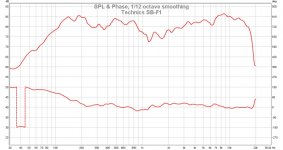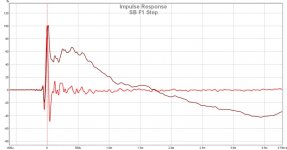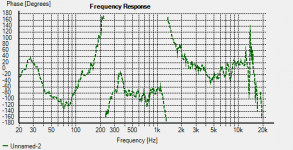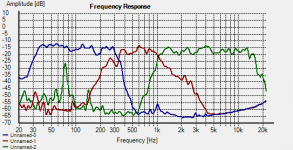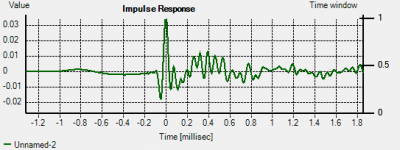I have to admit that I came up with the (1/fc)*0.36 by guesswork and experimentation. Looks like a slightly longer delay is better, for perfect drivers.
Combining different filter slopes to good results interest me, partly because one always seems to be doing that with real speakers.
Thanks for checking my work.
Combining different filter slopes to good results interest me, partly because one always seems to be doing that with real speakers.
Thanks for checking my work.

I think we are looking at a paper speaker like this time-aligned Technics SB-4000 to get transient perfect.
4th order 8" bass isn't hard, because that is what they do on simple second order electrical filters. And you can notch the Fs of a cone tweeter with a first or second order filter to get close to the 12dB/octave target slopes.
So we know what this speaker looks like.
Are there measurements of the Technics SB series anywhere? Would like to see IR and SR to see how close it is to transient perfect. Did they use 2nd order electrical LPF and first order electrical HPF? The 2kHz XO freq and wide band tweeter would certainly support that - and end up sort of like what I did with the FR58EX/AC130F1 project (except I went first order electrical all the way).
http://www.diyaudio.com/forums/full-range/280331-fr58ex-ac130f1-micro-fast.html
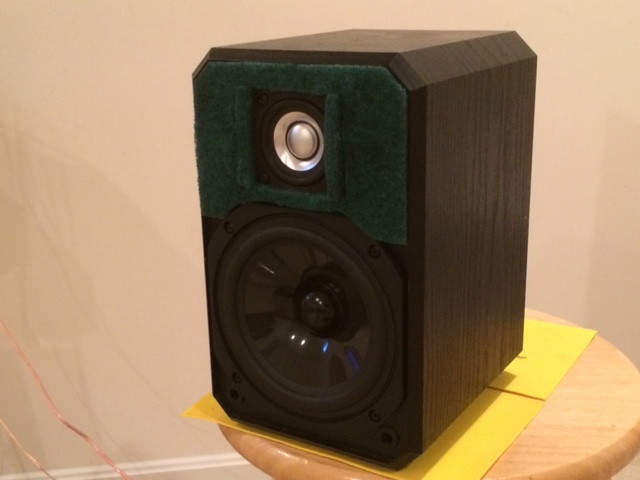
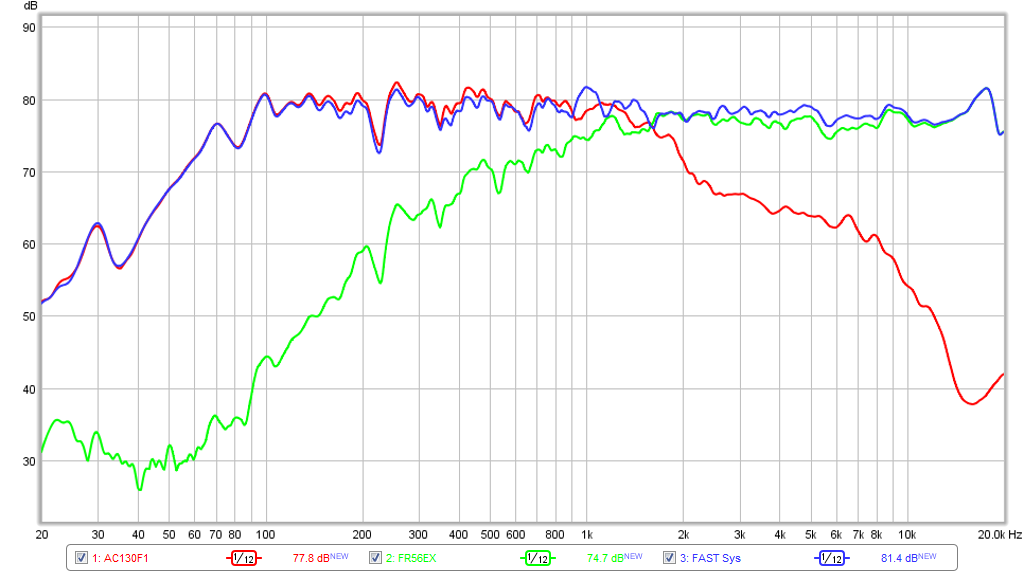
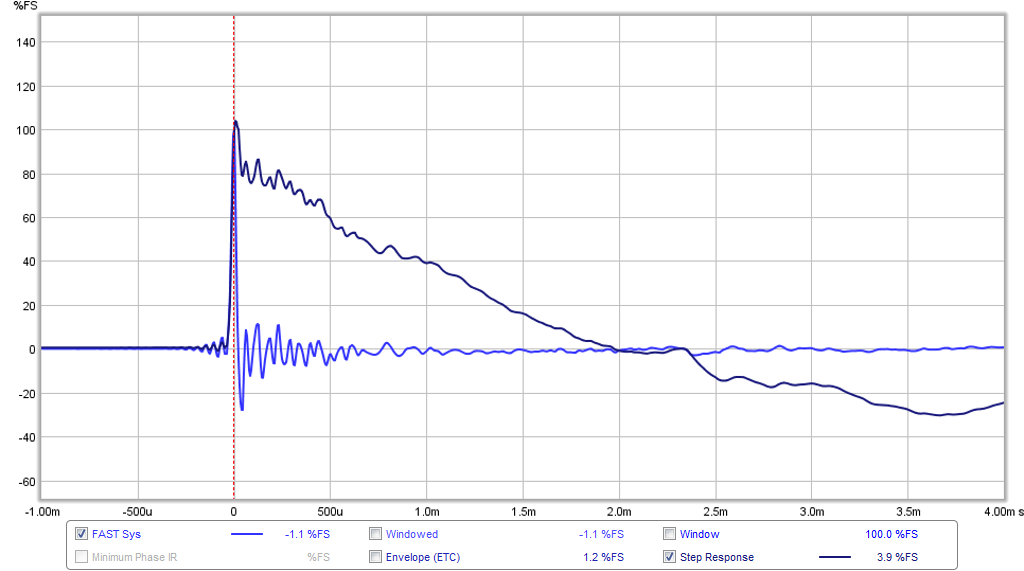
Now with an SB-4000 clone, one can mechanically delay the mid/tweet and have some hope of a passive XO.
Here you go.
This is a pair I have - they do sound lovely, but are obviously fairly small and volume limited.
If you can get hold of a pair cheaply - I thoroughly recommend!
Nice! The SR does indeed look a lot like a Harsch XO. The little dip in the phase response is also reminiscent of the Harsch. I wonder what the electrical XO slopes are? If possible, can you ever post a photo of the XO if you happen to go inside the box?
You have label of SB F1, is that the same as SB 400?
bushmeister,
Thanks sharing plots and picture link looks like a great speaker both visual and measured data.
Seeing you communicate with xrk971 reminds me your request over at wesayso's line array thread, and because xrk971 actual have showed that a full ranger can do stuff in a horn that maybe not was expected.
Have a look at this thread http://www.diyaudio.com/forums/full...ing-trynergy-full-range-tractrix-synergy.html.
Know its a long thread but in time look the two way horn xrk971 did, and also very interesting is the 300-20kHz horn member kees52 is in action with right now. Think there is great possibility in the design either its 1 way horn/two way system or 2 way horn/3 way system, and also a possibility is try some more expensive driver for the full ranger horn as example is FR88EX/B80/10F8424.
Thanks sharing plots and picture link looks like a great speaker both visual and measured data.
Seeing you communicate with xrk971 reminds me your request over at wesayso's line array thread, and because xrk971 actual have showed that a full ranger can do stuff in a horn that maybe not was expected.
Have a look at this thread http://www.diyaudio.com/forums/full...ing-trynergy-full-range-tractrix-synergy.html.
Know its a long thread but in time look the two way horn xrk971 did, and also very interesting is the 300-20kHz horn member kees52 is in action with right now. Think there is great possibility in the design either its 1 way horn/two way system or 2 way horn/3 way system, and also a possibility is try some more expensive driver for the full ranger horn as example is FR88EX/B80/10F8424.
Last edited:
Hi xrk971,
Over the weekend, I did some simulations on the polar response of the S. Harsch crossover on a 2 way loudspeaker, consisting of a 1” dome tweeter and a 6.5” bass/midrange driver. The spacing between the centres of these drivers = 5.5” and all of the simulated responses were in half space with the microphone on axis with the tweeter.
I first adjusted the crossover so that each driver matched the response of the S. Harsch target responses and then ran the sim’s in 5 degree increments over a +/-90 degree range. Attached are results of the FR at 0 degrees and +/-15 degrees together with the polar map showing the 200Hz and 2KHz responses.
From the polar map you can see that the response has a significant lobe that points downwards at the 2KHz crossover frequency. The FR graph also shows significant deviations over the +/-15 degree responses.
So this type of crossover may be best suited for symmetrical driver layouts like MTM, coaxial and Synergy type layouts, but I can’t offer any proof of this just yet.
Peter
Over the weekend, I did some simulations on the polar response of the S. Harsch crossover on a 2 way loudspeaker, consisting of a 1” dome tweeter and a 6.5” bass/midrange driver. The spacing between the centres of these drivers = 5.5” and all of the simulated responses were in half space with the microphone on axis with the tweeter.
I first adjusted the crossover so that each driver matched the response of the S. Harsch target responses and then ran the sim’s in 5 degree increments over a +/-90 degree range. Attached are results of the FR at 0 degrees and +/-15 degrees together with the polar map showing the 200Hz and 2KHz responses.
From the polar map you can see that the response has a significant lobe that points downwards at the 2KHz crossover frequency. The FR graph also shows significant deviations over the +/-15 degree responses.
So this type of crossover may be best suited for symmetrical driver layouts like MTM, coaxial and Synergy type layouts, but I can’t offer any proof of this just yet.
Peter
Attachments
Very interesting! Could you do a comparison to a regular LR24 type crossover?Hi xrk971,
Over the weekend, I did some simulations on the polar response of the S. Harsch crossover on a 2 way loudspeaker, consisting of a 1” dome tweeter and a 6.5” bass/midrange driver. The spacing between the centres of these drivers = 5.5” and all of the simulated responses were in half space with the microphone on axis with the tweeter.
I first adjusted the crossover so that each driver matched the response of the S. Harsch target responses and then ran the sim’s in 5 degree increments over a +/-90 degree range. Attached are results of the FR at 0 degrees and +/-15 degrees together with the polar map showing the 200Hz and 2KHz responses.
From the polar map you can see that the response has a significant lobe that points downwards at the 2KHz crossover frequency. The FR graph also shows significant deviations over the +/-15 degree responses.
So this type of crossover may be best suited for symmetrical driver layouts like MTM, coaxial and Synergy type layouts, but I can’t offer any proof of this just yet.
Peter
/Anton
Hi xrk971,
Over the weekend, I did some simulations on the polar response of the S. Harsch crossover on a 2 way loudspeaker, consisting of a 1” dome tweeter and a 6.5” bass/midrange driver. The spacing between the centres of these drivers = 5.5” and all of the simulated responses were in half space with the microphone on axis with the tweeter.
I first adjusted the crossover so that each driver matched the response of the S. Harsch target responses and then ran the sim’s in 5 degree increments over a +/-90 degree range. Attached are results of the FR at 0 degrees and +/-15 degrees together with the polar map showing the 200Hz and 2KHz responses.
From the polar map you can see that the response has a significant lobe that points downwards at the 2KHz crossover frequency. The FR graph also shows significant deviations over the +/-15 degree responses.
So this type of crossover may be best suited for symmetrical driver layouts like MTM, coaxial and Synergy type layouts, but I can’t offer any proof of this just yet.
Peter
Thanks for the sims - very informative. My first Harsch was in fact, an MTM with a 3.5in mid. I then applied it to a FAST with a 500Hz Xo. Maybe not as bad there?
Passive Harsch XO
Recently, I made a small clone of a PMC TL speaker, but implemented it with a Harsch XO using active miniDSP. It's a great sounding speaker and capable of bass that sounds like it comes from a larger speaker. With appropriate damping the response has a slow fall off in the low register enabling low group delay similar to a sealed alignment with a Linkwitz transform. More info here: http://www.diyaudio.com/forums/multi-way/281778-low-cost-pmc-inspired-tl-monitor-dc130a-dc28f.html
Photo of TL speaker:
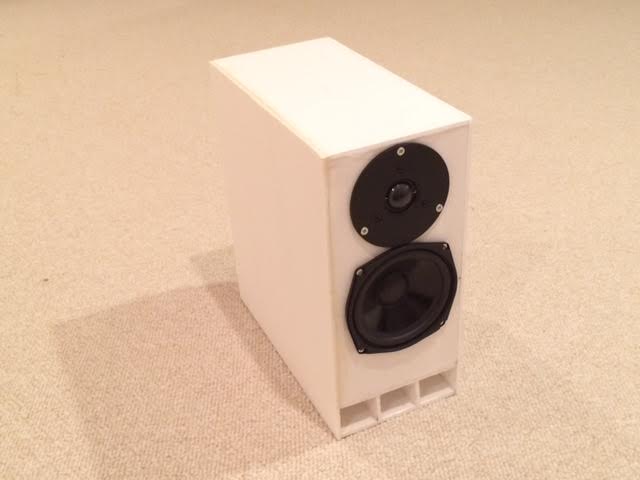
Measured Freq response using active miniDSP:
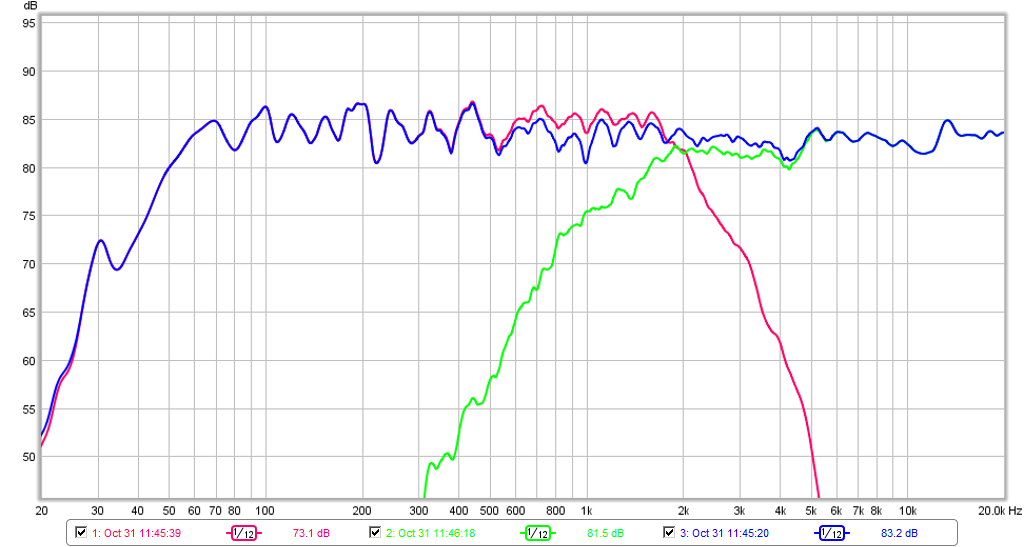
Measured SR using miniDSP:
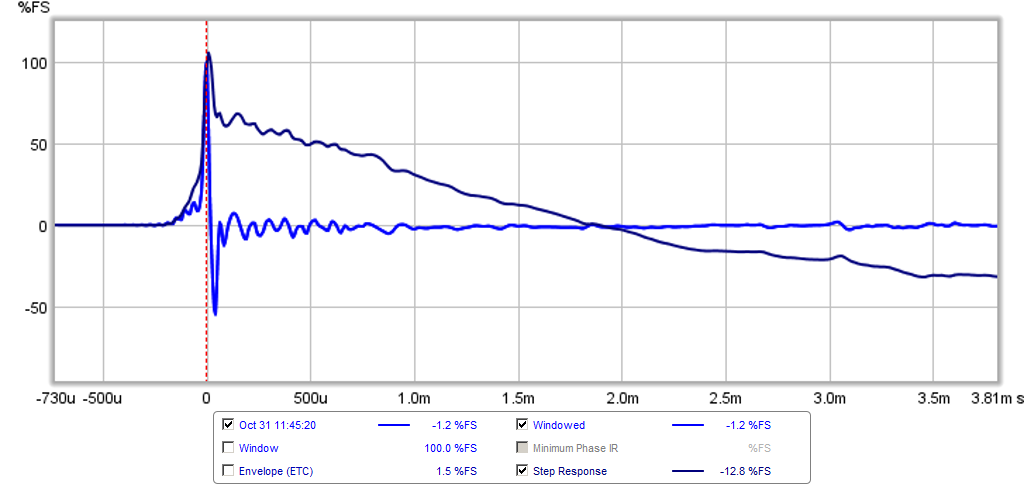
But, I finally took it upon myself to learn how to design a passive XO using PCD and Xsim, and I used this speaker as the first case, I designed a passive Harsch XO following a textbook target response of 4th order LPF for the woofer and 2nd order HPF for the tweeter. I set the XO at 2kHz and implemented the time delay by physical setback of the tweeter.
Here is the XO design (yes, it's complicated because I used several notch filters to flatten the response to make the overall result close to a "monitor" with flat SPL response. (Woofer on top and tweeter on bottom)
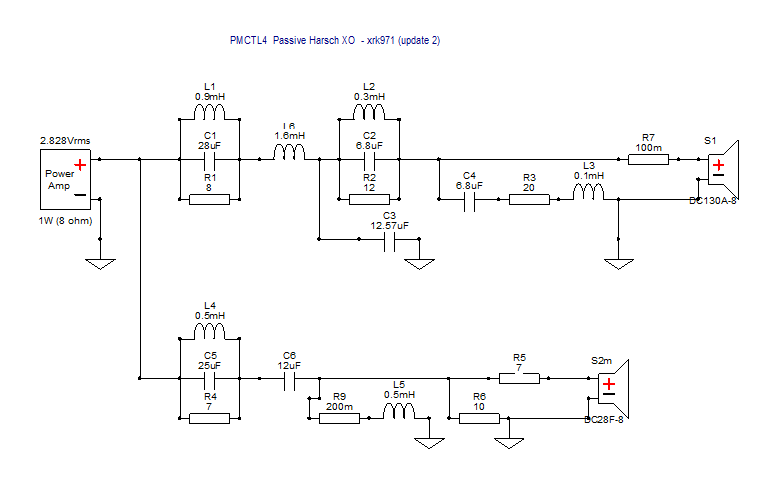
Here is the resulting predicted acoustic XO response:
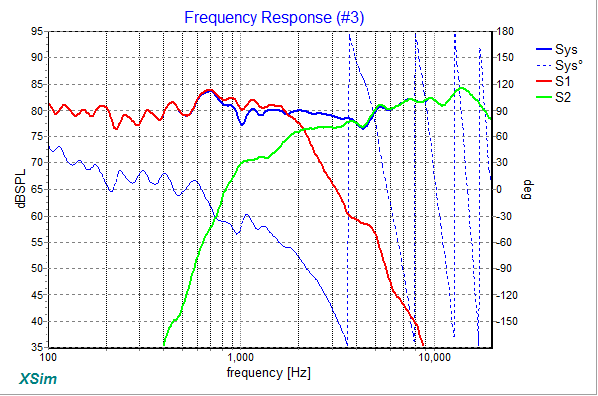
The predicted impedance the amp sees:
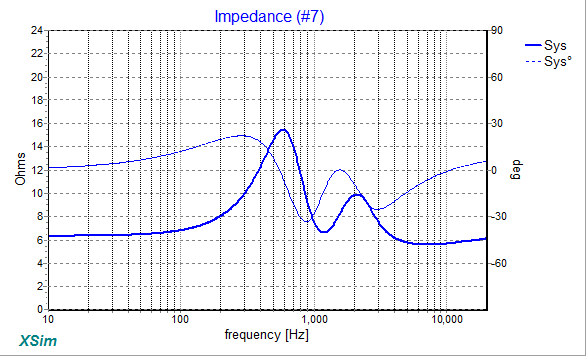
The predicted step response:
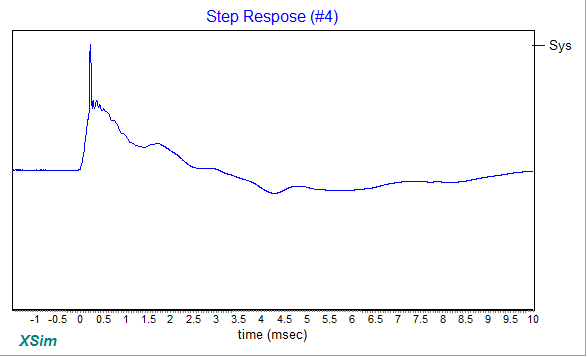
I do want to give thanks to Jeff Bagby (PCD) and Bill Waslo (Xsim) for providing the community with some excellent tools that enabled the XO design.
Recently, I made a small clone of a PMC TL speaker, but implemented it with a Harsch XO using active miniDSP. It's a great sounding speaker and capable of bass that sounds like it comes from a larger speaker. With appropriate damping the response has a slow fall off in the low register enabling low group delay similar to a sealed alignment with a Linkwitz transform. More info here: http://www.diyaudio.com/forums/multi-way/281778-low-cost-pmc-inspired-tl-monitor-dc130a-dc28f.html
Photo of TL speaker:

Measured Freq response using active miniDSP:

Measured SR using miniDSP:

But, I finally took it upon myself to learn how to design a passive XO using PCD and Xsim, and I used this speaker as the first case, I designed a passive Harsch XO following a textbook target response of 4th order LPF for the woofer and 2nd order HPF for the tweeter. I set the XO at 2kHz and implemented the time delay by physical setback of the tweeter.
Here is the XO design (yes, it's complicated because I used several notch filters to flatten the response to make the overall result close to a "monitor" with flat SPL response. (Woofer on top and tweeter on bottom)

Here is the resulting predicted acoustic XO response:

The predicted impedance the amp sees:

The predicted step response:

I do want to give thanks to Jeff Bagby (PCD) and Bill Waslo (Xsim) for providing the community with some excellent tools that enabled the XO design.
Last edited:
Tried a 3 way crossover with But48 low pass, Bess24 bandpass, But48 high pass. Crossover points at 350 and 1k.
Not a nice line but much better than the multiple phase wraps you would usually get with no delay.
Can you show us the xo plot and IR?
Yeah that 12" isn't doing much 
I'll give the B&O filter a shot after I give a good listen to this current setup. Although I might be at the best compromise before going to FIR. Those 18's aren't too pretty with shallow slopes. The compression drivers get a little ratty sounding at higher volumes.
I have tried rephase with foobar before. Definitely noticeable with some material when compared to 48db filters all around. Not sure I'll be able to differentiate the current setup to flat phase. Projects for another day!
Thanks for bringing light to this subject on this board. Added some fun to my system with no added expense.
I'll give the B&O filter a shot after I give a good listen to this current setup. Although I might be at the best compromise before going to FIR. Those 18's aren't too pretty with shallow slopes. The compression drivers get a little ratty sounding at higher volumes.
I have tried rephase with foobar before. Definitely noticeable with some material when compared to 48db filters all around. Not sure I'll be able to differentiate the current setup to flat phase. Projects for another day!
Thanks for bringing light to this subject on this board. Added some fun to my system with no added expense.
Recent post in B&O's Beolab Blog describing the so-called "Hole-Filler XO", which they now say is called the "Phase Link" driver XO. Sounds better than "Hole-Filler" (reminds me of patching a lawn infiltrated by gophers). Math is laid out very nicely and easy to follow.
B&O Tech: Uni-Phase Loudspeakers earfluff and eyecandy
I want one of these (or maybe a pair):
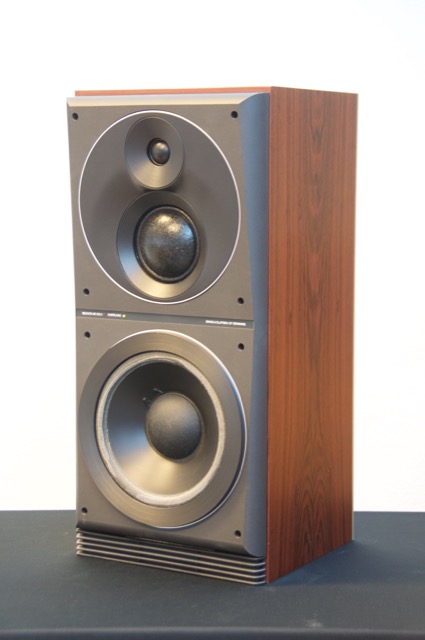
Perhaps one of those ATC 3in fabric domes may do the trick here? The dome in the above photo looks more like a 5in fabric dome. Where does one get something like that?
B&O Tech: Uni-Phase Loudspeakers earfluff and eyecandy
I want one of these (or maybe a pair):

Perhaps one of those ATC 3in fabric domes may do the trick here? The dome in the above photo looks more like a 5in fabric dome. Where does one get something like that?
xrk971 thanks sharing.
That its a 2-way where a certain controlled cancel pattern is supposed happen in acoustic domain to be filled by mid and tweeter verse woofer ctc distance looks some far away, think system may be very on axis sensitive to have filter represent advertised precision. Tech is very clever and if executed in electric domain it sum absolut perfect as there is no acoustic ctc problems but all drivers needs be very wide bandwidth and stricktly filter controlled. Agree speaker look awesome.
One could think about filter tech would suit a Syngergy horn, but oops even woofer itself has bandwidth injection port would low pass filter so it never gonna meet with tweeter response. Think we lucky in time with modern DSP tech and fair cheap power amps HARSH and FIR filters seems easyer way to go.
That its a 2-way where a certain controlled cancel pattern is supposed happen in acoustic domain to be filled by mid and tweeter verse woofer ctc distance looks some far away, think system may be very on axis sensitive to have filter represent advertised precision. Tech is very clever and if executed in electric domain it sum absolut perfect as there is no acoustic ctc problems but all drivers needs be very wide bandwidth and stricktly filter controlled. Agree speaker look awesome.
One could think about filter tech would suit a Syngergy horn, but oops even woofer itself has bandwidth injection port would low pass filter so it never gonna meet with tweeter response. Think we lucky in time with modern DSP tech and fair cheap power amps HARSH and FIR filters seems easyer way to go.
Yes, it's interesting how B&O classify this as a 2-way speaker based on woofer and tweeter frequencies and XO point as the middle is just to correct the phase anomalies from the 2-way. It's still a 3-way in my book - anytime a mid is that extensive and "prominent".
I agree today DSP and FIR lets us fix all of this but very cool how an all analog solution existed in the 70's. I wish they had actual measurements to share.
The math is without a doubt, elegant. I love when a proof ends with F(s)=1.
I agree today DSP and FIR lets us fix all of this but very cool how an all analog solution existed in the 70's. I wish they had actual measurements to share.
The math is without a doubt, elegant. I love when a proof ends with F(s)=1.
- Home
- Loudspeakers
- Multi-Way
- S. Harsch XO
